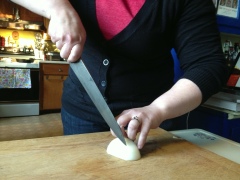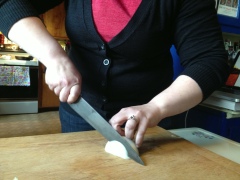So far we have learned about the anatomy of the knife, the proper way to hold a knife, and how to sharpen a knife. The next step is how to use the knife.
Slicing and dicing: The tip of your knife is for quick short chopping strokes, the heel of your knife is best utilized for cutting into large objects that need more force behind them.
When slicing it is best to keep in mind that this is a rocking motion. You don’t want to bruise the food by forcing your way through it. You want to glide into that onion in one smooth, clean motion.
The knife should act as an extension of your arm. Motion begins in the big joints and is transferred to the smaller joints by momentum. Point your knife tip down, glide down and out, following through to ensure you have sliced all the way through.
Try slicing into an onion with this technique, then try forcing the knife through. Pay attention to how your arm feels and note how much force you need to exert. Listen to the knife too. A beautiful arching slice will result in the blade singing out one clear tone, while the forceful cut will result in an unpleasant 2 toned dull sigh.
Holding your food: Not only is how you hold the knife important, so is how your hold your food. I would like to introduce you to the “claw” grip. In this grip, you are minimizing the exposure of important and tender fingers by curling them under, and exposing the flat portion of the first knuckle.
The beauty of this “claw” grip, is that your gripping hand is actually guiding your knife. Your knife, which is guided by your first knuckles, does not need to move, other than the up and down motion of slicing. Your claw does not move either. Your thumb, is in the back pushing the food forward to meet your blade. With experience you will find that you can use your claw grip to measure your slices.
 Sounds confusing? Lets break it down:
Sounds confusing? Lets break it down:
- Cut an onion in half and peel off the outer dry skin, place 1/2 of the onion on your cutting board.
- Grip your knife with the “proper knife grip”
- Grasp your onion with your guiding hand in the claw grip, your thumb should be resting on the butt of the onion.
- Slice into the onion once then lift your knife
- With your knife lifted, gently push the onion forward toward the knife, under your claw, with your thumb.
- Continue slicing.
Why exactly is it critical to break down how we cut our food? Each day we nourish ourselves and our family. The food we introduce to our body is just as important as fresh air, sunlight, water and plenty of sleep. Have you ever heard of the saying “our body is our temple”? Until science proves otherwise, we only get this one body. Our bodies are how we experience the physical side of our humanity. How our body moves is a direct result of many decisions that we make. The food we eat is one of those decisions.
I whole heartily believe that cooking is a sacred rite. By cooking for ourselves and our loved ones, we are taking responsibility for our bodies, our temples. Take joy in this ritual and master the nuance and detail of it so that you can enjoy the art of cooking. After all of your hard work, you will make knife wielding appear effortless. You will be able to approach that onion with confidence and grace, and be rewarded with the simple joy of the action.
This may seem like abstract thinking to some, but to me this is completely focused. To relate to another part of my life: Three years ago, I sustained what appeared to be a minor injury to my back. What I didn’t realize was that I began to alter my entire body to deal with the pain. Recently, I have been given the opportunity to go to physical therapy. I have learned that my entire posture and walking gait are main contributors to my pain. Now I have to break everything down, I am relearning how to stand and walk. Every moment I am standing, I am running through a mental check list to make sure that I am in proper alignment. I am putting in all of the hard work now, so that down the road I am better, faster, and stronger.
This is my goal with these knife posts, to help you become better, faster, stronger and hopefully more confident with your tools.










Congrats,Lea. and mom too Thanks for the memories.